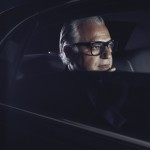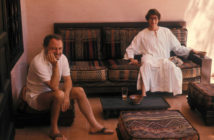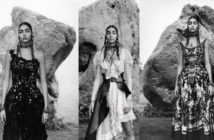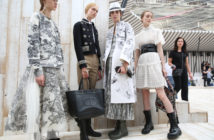Power to the People
 By John Ortved
By John Ortved
Photography Robbie Fimmano
Joe Mimran
Canada has never been known for producing titans of the global fashion industry—with one notable exception. In 1985, Joe Mimran, who was born in Casablanca but moved to Toronto at age 5, created Club Monaco, a fashion brand and chain of stores that presented an urban uniform built on casual minimalism. By the time Mimran sold Club Monaco to Ralph Lauren in 1999 for a reported $52.5 million, he had expanded not just across Canada, but internationally, having opened stores in the U.S. and abroad. When Mimran built Club Monaco, he was appealing to our brains. “I’ve become known for black-and-white because that was my palette at Club Monaco for 15 years or longer,” the 59-year-old father of four says from his sleek white offices in New York’s Chelsea
neighborhood. “I collected black-and-white photography and I only wore black-and-white; my house was all black-and-white and neutrals.” But with his more recent endeavor, Joe Fresh, Mimran is shooting for
something more visceral.
Joe Fresh launched in 2006 at the behest of Canada’s supermarket giant
Loblaws, which was looking to sell apparel in its grocery megastores
across the country. Mimran was intrigued, but didn’t want to produce
the cheap, characterless slurry that overflows from the shelves at
Walmart and Kmart. “Nobody was approaching it from a branded
perspective,” he says. His solution was to design a playfully
Technicolor but chic wardrobe—from classic crewneck tees to maxi
skirts to denim trench coats—that could be sold at very low prices.
“That’s where all of these clean colors came out of, this desire for
the product to be tasty,” he says.
As Joe Fresh began to grow, Mimran made a crucial observation: “The It
gals that are buying Prada and Vuitton were coming in and secretly
shopping Joe Fresh,” he recalls. Mimran believed the label could stand
on its own as a retail brand, and he looked to extend it beyond
Canadian borders. As he’d done with Club Monaco in 1995, Mimram
planted a firm foot in New York City, where in early 2012 he
established a Joe Fresh flagship store on Fifth Avenue, just blocks
from Japanese giant Uniqlo, which has become a behemoth trafficking in
affordable clothes in candy colors. “I think Uniqlo is definitely
competition, but you never get knocked out of the box because of your
competitor in fashion,” says Mimran, whose interest in contemporary
art helped usher in his brighter palette (painter Alex Katz is a
favorite). “You go to Topshop, you go to H&M. Would you go exclusively
to one of those stores? No way. It’s such a fragmented industry.
Nobody has 5 percent market share. There’s always room for good
competition.”
For Mimran, the six Joe Fresh stores in New York and New Jersey are
merely a beachhead, but it isn’t all about market saturation. “For me,
the thrill is really in developing a brand that has integrity,” he
says. “Why does price automatically put you into the category of
copier? Why can’t I be as creative? Being unique doesn’t have to be
expensive.”
Oskar Metsavaht
Oskar Metsavaht may well be one of the most learned men in fashion.
Certainly he’s one of the only designers to hold a doctorate in
medicine. An orthopedic physician by training, the 51-year-old
Metsavaht is also the founder and creative director of Osklen, the
Brazilian apparel company that is looking to assert itself as the
nation’s first global fashion brand. Currently selling in 15
countries, with 63 stores in Brazil, 9 more outside of those borders,
and with lofty investors circling like sharks, it looks as though
Osklen is well on its way. “Clothing is to protect from cold, from
rain, from heat, from sun,” says the chiseled Metsavaht, who calls the
Rio de Janeiro neighborhood of Ipanema his home. “Also, physicians
learn to observe details about human behavior. Through fashion, the
human body interfaces with the environment. Who better to understand
this relationship?”
The genesis of Osklen has a direct connection to the good doctor’s
medical experience. Finding the available winter gear lacking,
Metsavaht, an avid outdoorsman, snowboarder, and skier, designed his
first weather-resistant jacket for a climb in the Andes in 1986, where
he was accompanying a group as the expedition doctor. The garment was
so well received that he decided to begin manufacturing it. Over the
years, his vision for Osklen has expanded beyond outer-wear to
comprise a complete wardrobe for men and women, including footwear and
sportswear. Metsavaht’s aesthetic is minimalist, unisex, and
functional, inspired by the designs of Oscar Niemeyer and the Bauhaus.
“People think, ‘Oh, because Oskar is interested in sports or is a
physician, he thinks about comfort first,’” he says. “No, I think
aesthetics. I like beauty.”
Metsavaht’s other intention for Osklen is to create a degree of
sustainability. Not only are all of his stores in Brazil
carbon-neutral, but in 2000 he started the Rio-based Instituto-e,
which creates sustainable projects in nearby favelas and poor
Amazonian communities, often utilizing their fishing and agricultural
technologies in the production of materials for accessories and
clothing. It’s a project that has won Metsavaht nods from the World
Wildlife Fund and UNESCO. “It’s a culture inside the company. We have
to try to be as sustainable as possible without undermining what we
need to do economically,” he says. “I don’t see my company or my
career as a fashion designer as a green brand. I’m an artist. I’m a
creator. It’s an expression of a lifestyle. My lifestyle is not 100
percent sustainable.” The Osklen lifestyle is an enviable one. “I
chose an artist’s way of life instead of medicine,” Metsavaht says.
Current Issue
August 2012
Subscribe now
|Like Interview
|Follow Interview
MoreFASHION
First Dibs: Givenchy Resort Look 13
Casting Call: Hugh Hefner
At the Center of Waris Ahluwalia’s Universe
Thierry Gillier
Zadig & Voltaire, the Paris-based casualwear brand founded in 1997 by
Thierry Gillier, has some very impressive roots. First, there’s
Gillier himself, whose great-grandfather was one of the founders of
Lacoste. Then there’s the company’s auspiciously literary name,
referencing Zadig, the handsome young Babylonian philosopher and hero
of the 1747 novel of the same name, and Voltaire, the writer of the
French Enlightenment who authored it. Under that banner, Gillier has
created a clothing brand that marries Parisian street style with a
tough rock ’n’ roll mentality.
Even when Gillier has talked about his clothes embodying “street
fashion at first glance,” there’s still a lot of thought packed into
them. “Paris street fashion is something more intellectual,” he says.
“In France, it’s more tight, more serious.” Zadig & Voltaire’s
remarkable ascent—from a single, humble shop in the
Saint-Germain-des-Pres neighborhood, opened in 1997, to almost 200
stores worldwide today—has much to do with Gillier’s intuition in
capturing, packaging, and marketing this imprimatur of cool. “There
was something new and modern lacking in the French fashion world,” he
says. “I had a vision of how to make women desirable and feminine in a
more natural, less sophisticated way.” He saw his ideal woman as at
once composed and kick-ass. “When a woman wears clothes in a masculine
way, she becomes so sexy and she stays young. And I knew exactly how
to create that silhouette.” First by word of mouth, and then, over the
past few years, with devilishly chic ad campaigns featuring the likes
of Mark Ronson (“I met him in a bar in Paris—very handsome, dressed
very specifically—he was kind of a new Bowie,”) and downtown New York
lioness Erin Wasson (who also designed a Z&V capsule collection for
Fall of 2011), Gillier has built a singularly powerful line. “Brands
like Chanel left a place for a new, more accessible brand like Zadig,”
he says. “Before me, there didn’t exist anything between H&M and these
ultraluxe brands, and I invented this new aspect of French fashion.”
In fact, with the growing popularity of Z&V, there has been recent
speculation in the French press about private investors buying a stake
in the company. That money might prove necessary if Gillier decides he
wants Z&V to compete on the megabrand level of brands like Zara, or
even GAP in its heyday, a company he greatly admires. “The guy from
GAP [Mickey Drexler, the former CEO] was really clever to make clothes
for parents, children, every kind of people,” Gillier says. A
certified French fashion aristocrat like Gillier holding up GAP as a
model is the kind of incongruity that might give Parisian fashion
snobs pause, but the notion is one that Voltaire himself might have
appreciated. “All styles are good,” Voltaire once wrote, “except the
tiresome kind.”
Johan Lindeberg
At the moment, Johan Lindeberg isn’t consumed by fashion. Sitting in
the back of the Swedish industry titan’s BLK DNM shop on SoHo’s
Lafayette Street, Lindeberg is getting emotional about photography. “I
started to shoot like a year ago, and I’ve never felt anything like
this before in my life,” says Lindeberg, enthusing behind his
signature lengthy beard and Norse eyes. He has just finished shooting
singer Lykke Li and actress Stella Schnabel for the BLK DNM blog, and
playfully reenacts some of the dramatic camera angles. “It’s very
direct somehow. It’s just something I had in my body for so long,” he
says about his new passion. “I’m almost crying when I think about it.”
In a larger sense, though, Lindeberg cares desperately about clothes.
His 20-year career has seen him help Diesel become a behemoth in the
’90s, first as marketing director, and later as the company’s U.S.
CEO. He left to create his eponymous Swedish golf line, J. Lindeberg,
which, by the time it was sold in 2007, had xpanded into a global
lifestyle brand. He even found the time to help Justin Timberlake
become a fashion entrepreneur as the creative director of the pop
star’s own clothing label, William Rast. Lindeberg’s latest endeavor
is a line of luxury basics for men and women called BLK DNM, marked by
a spare aesthetic—tailored, pared-down sweaters, denim, and leather
jackets that are numbered, not named, like the tapered “Jeans 8.” “I
wanted to create a new brand where I can really express myself,”
Lindeberg says. “I think BLK DNM is a manifestation of everything I’ve
done in the past somehow, and created in a very personal way.”
Whether taking pictures or reimagining street style, the act of
creation for Lindeberg seems to come from the core. “I’ve been living
everywhere,” he says. “When I split with my wife in 2010, I went to
Montauk. I cried for three days. I walked on the beach. And I decided
I was going to be a New Yorker full-time, forever. That’s why I want
to create something using energy from downtown.” With BLK DNM stores
in NYC and Stockholm, as well as boutiques from Hong Kong to Canada
selling their wares, Lindeberg’s very personal vision is proving, once
again, universal. So far in the past year the designer has released a
fragrance, collaborated on sunglasses with Moscot, and been named by
GQ as one of the best new menswear designers. “I would rather be it in
women’s fashion, to be quite honest,” he says. “It’s more chal-
lenging. But it doesn’t matter. I like to do both.”
For Lindeberg, the accolades and the successes are secondary; toiling
away in BLK DNM’s workshop beneath the store, about town at a few of
his favorite night clubs, and strolling in the West Village with his
11-year-old daughter Blue are the constant inspirations. “I think I
found something,” he says. “I always have pain in my body, all my
life, but somehow I feel less pain now than ever. I’m deeper in my
intuition, and more pure in my taste than I’ve ever been.”
MoreFASHION







